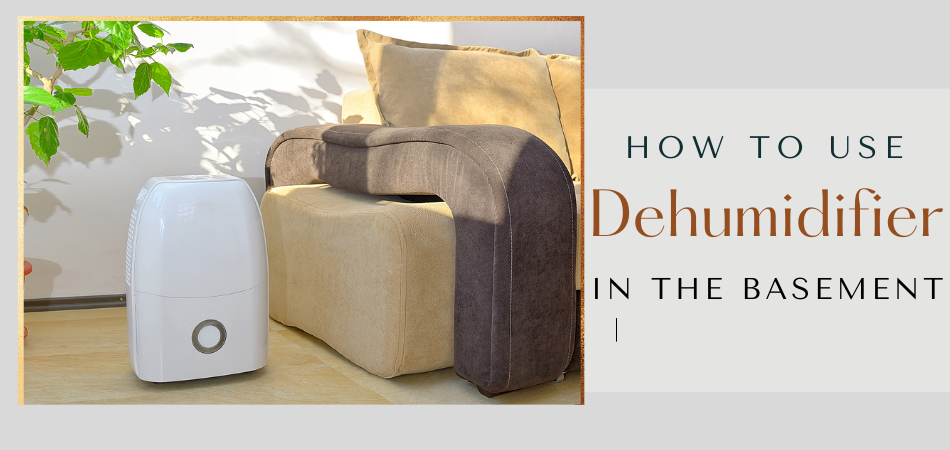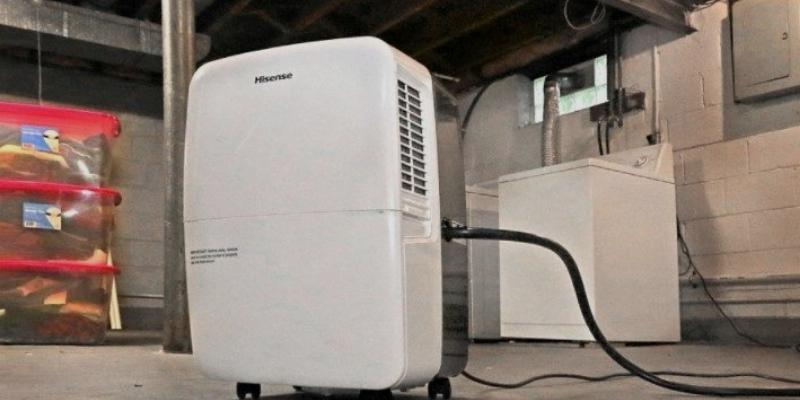Have you ever wondered how to use a dehumidifier in a basement? Perhaps, you can’t make heads or tails of the equipment? Or you’re clueless as to which type to purchase or why you even need to get one in the first place? Well, you’ve come to the right place.
A survey has it that about 30% of homes built in 2013 have either basements or crawl spaces. Which is way less than the percentage of houses that do in recent times. That being said, it’s no news that most homeowners with basements in their homes have a common problem with maintaining their humidity levels.
One of the most effective ways of doing so is by getting a dehumidifier. Sadly, simply having the dehumidifier isn’t enough. How do we use it? Perhaps you seek to get answers to questions such as: Does it help the whole house? Where should it be placed in the basement? and why? Well, let’s answer them together, shall we?
Will A Dehumidifier In The Basement Help The Whole House?
Through several factors, heat and moisture make their way into the basement and the recruitment of the dehumidifier helps rid the basement of it. However, will the work of the dehumidifier down in the basement assist the rest of the household up top? The answer is yes.
We need not delve much into its functions as its name tells much of what it was made for. However, let us examine its use in a basement. The basement being the lowest part of a building tends to get humid because of the lack of windows and its position close to the foundation.
Factors such as the stack effect, capillary action, and diffusion, allow moisture to make its way from the basement to the rest of the house above. This causes tons of damages that could be averted if a dehumidifier is present in a basement.
How To Use A Dehumidifier In The Basement
Having a dehumidifier in the basement is one thing, knowing how to work this piece of moisture-sucking equipment is another. Its use depends on a major factor;

The size of the basement
The use of the dehumidifier in a small or large basement varies. In a small basement, both the size of the dehumidifier and the room matter. It’ll be effective to use a small-sized dehumidifier in a small room. In a large-spaced basement, a larger one will suffice. One like the Home labs energy star dehumidifier.
How Long The Dehumidifier Should Run?
Ridding a room of lingering humidity is a top priority for most homeowners especially during the summer. Temperature levels may spike throughout the day tempting most to leave a dehumidifier running all through the day.

Except you receive fat checks at the end of the month, this would not be advisable. Running up your electricity bills would inadvertently create moisture on your brows. If you must run it all day long, using a battery-operated dehumidifier like the wireless mini dehumidifier could cut down on expenses.
Regulating the dehumidifier to work and stop at certain points will prove useful, like the ALORAIR 120 PPD commercial dehumidifier, if the one you have is built that way. If yours isn’t built like that, manually operating it is the next best option.
That being said, we know when it should be switched on. When it should be turned off, however, generates the itch for most people. When the relative humidity has been attained, it’s time to turn it off. By relative humidity, I mean when a level of moisture and temperature enough to make us comfortable has been reached, we can go ahead to turn it off.
Why Put A Dehumidifier In A Basement?
A common problem associated with a basement is its tendency to house molds. Molds are known to grow in damp settings. Their very presence alone should answer the question of why put a dehumidifier in a basement?
Molds left to play around could act as a trigger for health issues and act as allergens to residents. That being said, dehumidifiers help to rid your basement of molds.

Another reason why the dehumidifier is placed in the basement is to help prolong the structural lifespan of the homes they are housed underneath. Moisture in the air leads to complications such as wood rot, cracked ceilings, and damp walls.
It improves the overall indoor air quality. That is confidently getting rid of musty smells hovering around in your basement. You get to keep at bay any respiratory complications whatsoever.
Once again, if you aren’t scared of running up a bill, you can refuse to place one in your basement. Hopefully, you don’t spend nights at the ICU when mold spores attack.
Where In The Basement Should You Place A Dehumidifier?
The dehumidifier’s placement in the basement matters a great deal if you want an optimized experience. The ideal positioning should be at the center of the basement.

However, some factors determine this:
The Room Size:
A big room would call for the centralization of the dehumidifier so that moisture can be drawn in from all corners for optimal results. Although cord length matters in this case. A shorter cord would restrict its placement at the center of the room. It will be best to get a longer one that is also compatible with your dehumidifier type.
Drainage Method:
After collecting moisture from the air all day, the water needs a place to go. Compartments designed to house it get full after some time and emptying is required. Dehumidifiers come in different shapes and sizes. Manufacturing specifications also vary. While some have an automatic drainage system, others do not. The manual system would require you to be near an outlet to dump the collected water. This influences where the machine should be positioned.
The Positioning:
The dehumidifier works by sucking the moisture from the air. To do so effectively, it is designed with temperature sensors used to help detect the heat and moisture contributing to the humidity and relative humidity. Its nearness to a window means its exposure to sunlight or wind from open windows or in this case, a door leading to the upper floors. This could very well confuse the functions of the dehumidifier as its readings will be affected. In some unavoidable cases, it is best to make the room airtight by shutting all access to external aeration while the appliance runs.
Frequently asked questions (FAQs)
What Should A Dehumidifier Be Set At?
A dehumidifier usually targets to keep the humidity level at 30-50%. And you only need to turn it on when humidity needs to be reduced.
Setting it at 40% will help do the trick. At this point, it is almost an average setting which is fair enough. Considering the type of dehumidifier, in this case, is also essential.
When to Run a Dehumidifier in the Basement?
The ideal moment to run the dehumidifier in the basement is when humidity levels have
risen to eighty percent. A healthy indoor humidity should be between 30 to 50 percent. Any higher, and the moisture in the air increases. This makes it possible for mold to become a nuisance. Molds combined with high humidity create damp walls and rusting. Healthwise, heatstroke comes into play.
Do You Need a Dehumidifier in the Summer?
Yes, summer is the ideal time to use a dehumidifier as humidity gets the highest. The dehumidifier not only rids the air of moisture but facilitates cooling.
During the summer, heat waves cause the air to be unbearably hot and stuffy. Having a
dehumidifiers would lower the chances of discomfort and keep health issues at bay.
Summer is also when rainwater runs through the gutters and sometimes starts to dampen the walls. And dehumidifiers can prevent damping and keep your stored items at the garage and basement from rusting.
How Does A Dehumidifier Operate?
It’s a simple machine that operates by drawing air, extracting the moisture, and turning it into liquid. The air without the moisture is then blown back out. The liquid is then passed through an outlet for disposal.
Moisture floating in thin air is what contributes to high humidity. On hot summer days, these water particles trap heat and make people uncomfortable. As the dehumidifier removes the excess moisture, the air gets cooler, and you’ll feel at ease.
What is a Dehumidifier’s Electrical Power?
Dehumidifiers are manufactured in different sizes. An average 25-30 pints dehumidifier needs approximately 280 watts of electricity to function as designed. That’s way less than your average air conditioner that takes around 3000 watts.
Although the electricity consumption rate varies among different dehumidifier units, it’s still less than most house appliances like AC, hairdryer, iron, etc.
Conclusion
Molds, wet walls, and Mildew are common, especially during the hot season and in certain parts of the house. However, they only lay their claim in the absence of a dehumidifier, especially in the basement. Letting them be can prove harmful both healthwise and structural-wise. Trusting a dehumidifier to help keep them at bay might just be the best decision you’ll make.
Using a dehumidifier in a basement poses no challenge whatsoever. The main attention-giver would be the oversights of keeping a dehumidifier out of the basement. Its usage is easy to comprehend and profitable in more ways than one. It’ll be best to get one as soon as you possibly can.
